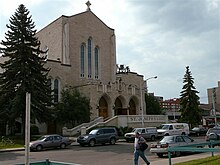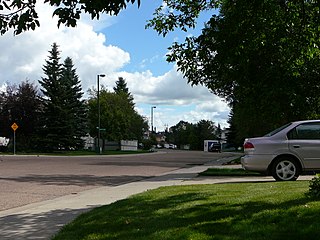Oliver | |
|---|---|
Neighbourhood | |
Location of Oliver in Edmonton | |
| Coordinates: 53°32′35″N113°31′20″W / 53.54306°N 113.52222°W [1] | |
| Country | Canada |
| Province | Alberta |
| City | Edmonton |
| Quadrant [3] | NW |
| Ward [3] | O-day’min |
| Sector [4] | Mature area |
| Area [5] | Central core |
| Government | |
| • Administrative body | Edmonton City Council |
| • Councillor | Anne Stevenson |
| Area | |
| • Total | 1.72 km2 (0.66 sq mi) |
| Elevation | 666 m (2,185 ft) |
| Population (2019) [8] | |
| • Total | 18,180 |
| • Density | 10,569.8/km2 (27,376/sq mi) |
| • Change (2016–19) | |
| • Dwellings | 13,884 |
Oliver is one of the oldest residential neighbourhoods in the City of Edmonton, Alberta, Canada.
Contents
- Demographics
- Residential development
- Population mobility
- Shopping and services
- Religious assemblies
- Surrounding neighbourhoods
- References
- Further reading

Oliver is immediately to the west of the downtown core, and overlooks the North Saskatchewan River valley south of the neighbourhood. Located in the river valley immediately below Oliver is Edmonton's Royal Glenora Club, Victoria Golf Course, and Victoria Park. The High Level Bridge and Groat Bridge give residents access to the south side of the river valley, including the University of Alberta and Old Strathcona. The Victoria Promenade (part of Edmonton's Heritage Trail) offers attractive vistas of the river valley at the western end of Oliver.
Oliver is one of the densest neighbourhoods in Edmonton (10,570 inhabitants per square kilometre (27,400/sq mi) [7] [9] ) and West Oliver is the densest area in Alberta. The population in 2009 was 18,203, the highest of every neighbourhood in Edmonton. [10]
The north edge of the neighbourhood was once a Canadian National Railway yard. This part of the neighbourhood was recently redeveloped, and includes apartment buildings, the Unity Square and Unity Square West strip shopping centres, some old warehouses converted shops, and parking for the MacEwan University downtown campus.
The community is represented on the Edmonton Federation of Community Leagues by the Wîhkwêntôwin Community League, established in 1922. [11] [12]
The neighbourhood is named after Frank Oliver, an early Edmonton resident, businessman, and politician. In January 2024, the city's committee on names selected wîhkwêntôwin ( Cree for 'circle of friends') ( /wiːˈkwɛntəwən/ ) to replace Oliver and sent this recommendation to city council. [13] On February 21, the city council officially approved the renaming of the neighborhood to wîhkwêntôwinᐄᐧᐦᑫᐧᐣᑑᐃᐧᐣ, [14] [15] which will be in effect on January 1, 2025. [16]












